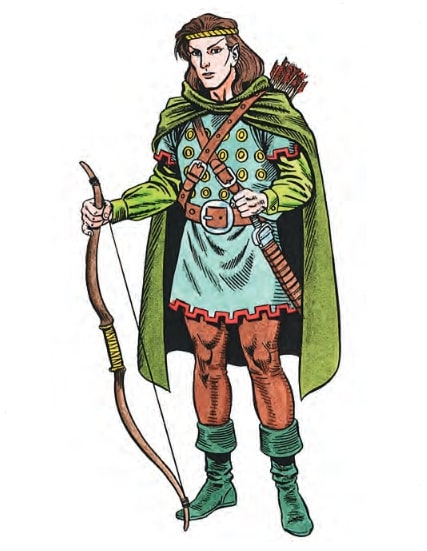World-Building: The Elves
Elfland’s Ethics & World Building | World-Building: Causes & Consequences | World-Building: Geneses | World-Building: About Alignment | World-Building: The False Light
Nota Bene: The descriptive preface has changed a bit from earlier iterations. Elven abilities have changed quite a bit from the B/X D&D norm.
Har Marei, the Queen of Waves and Lord of the Moon, created the elves from coral and seafoam. She brought to life Indóar and Lona, the first elves, through an infusion of her own blood, and she blessed them with the dolphin’s playful heart and the shark’s predatory instincts. He also made their forms changeable and cyclical, like the tides below and the phases of his lunar abode above. Har Marei gave Indóar and Lona dominion over the seas and all coastal places.
Elven warrior-wizards built cities and ships. The First Age began when elven longships cut through the waves from Avallen, the elves’ ancestral homeland, to land on the Western Shore. The elves conquered most of Belgica and Gaal, imposing elven administration over the disparate human tribes of the region. The elves controlled the region from the Western Shore to the Duna, along the shores of which they built several fortress-cities to guard against the militaristic dwarven clans that were consolidating their control over the mountains lands and plains of the East.
The First Age ended when those dwarven clans crossed the Duna to wage a war of conquest against the elves. Many humans sided with the dwarves, adding civil war to the chaos caused by dwarven aggression. Today, the elves still control a few strongholds along the Western Shore as well as several islands, most of which serve as ports of call for elven pirate-lords.

Prime Requisite: Strength, Intelligence
Hit Die: d6
Level Limit: 10
Multi-Class Options: Cleric, Thief
Elf Special Abilities
These special abilities replace those described in the standard rules.
Armor and Weapons: Elves can wear any armor, use shields, and wield any weapon. They excel with bows and one-handed swords, gaining a +1 to-hit bonus with these weapons.
Duality: All elves are both male and female, both martial (makar) and magical (istar). When an elf PC is created, the player must decide which sex corresponds with which adjective. Thus, an elf can be a magical male and a martial female, or vice versa. The player may modify ability scores to generate two sets of scores, applying one set to each form. At moonrise each day, an elf’s sex changes. An elf can attempt to resist this change by making a saving throw versus spells. When an elf changes form, the elf recovers 1d6 lost hit points. In either form, elves are immune to the paralyzing touch of ghouls.
Keen Senses: Elvish eyesight is not especially acute or able to pierce darkness, but their senses of hearing and smell are keen. Against a creature that can be heard, elves adds +1 to their surprise rolls. Against an injured creature that can bleed and that is within 30 feet, elves enjoy a +1 to surprise rolls against that creature. The DM may adjudicate that extenuating circumstances modify the range of this latter ability. These bonuses are cumulative.
Languages: Elves speak Common and Elven. (Nota Bene: Additional languages specific to certain races are still under construction.)
Skilled: When making an ability check to locate secret or hidden doors, reduce the difficulty by 1d6.
Istar Special Abilities
Combat: In istar form, an elf resolves attack rolls using the same table as magic-users.
Saving Throws: An elf in istar form receives a +2 bonus on saving throws against charm and sleep. The elf also receives a saving throw against sleep magic, even when the magic does not normally permit a saving throw.
Spellcasting: Like the magic-user, an elf owns a book of spells, which does not necessarily include all of the spells on the standard lists. Reading from this book, the elf presses select spell formulae into the mind, thus “preparing” those spells to be cast. Once a prepared spell is cast, the spell formulae disappears from the elf’s mind, and must be prepared again before another attempt can be made to cast it. However, it is possible to prepare a spell multiple times using the available “slots” in the elf’s memory. If the elf finds spell scrolls during an adventure, those can be copied into the spellbook.
Warrior-Wizards: Elves in istar form can wear any armor while casting spells. They cannot use shields or wield weapons at the same time since spell-casting requires that the caster’s hands be free.
Makar Special Abilities
Blood Frenzy: When engaged in melee against an injured creature that can bleed, elves in makar form gain a +1 to their “to hit” rolls. This bonus stacks with the bonus received from using a one-handed sword.
Combat: In makar form, an elf resolves attack rolls using the same table as clerics.
Saving Throws: An elf in makar form receives a +2 bonus on saving throws against fear and sleep. The elf also receives a saving throw against sleep magic, even when the magic does not normally permit a saving throw.

Leave a Reply